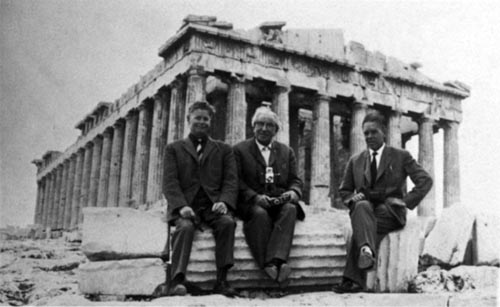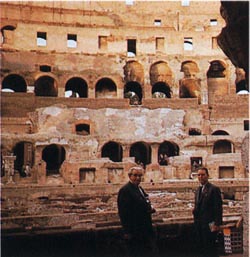Memoirs
Part 6
by Martinus
Wasn't it in the beginning of the 1940's that you got a new secretary and lecturer?
Yes, I think it was in 1942. His name was Mogens Møller and he was 28 years old at the time. During a visit to his old mother in Slagelse, one day he was walking along one of the town's streets when a little book called "Martinus" caught his eye; it was lying in a box of books outside a second-hand bookshop.
He bought the book and read it with great interest. And when he came back Copenhagen the next day he went immediately to our office and spoke to my secretary, buying more of my books, too.
Mogens Møller developed very quickly and became a very good lecturer; he was, chosen to give lectures mainly in Jutland since he and his wife and two daughters were to settle in Århus. The beginning of his career as a lecturer was not, however, without drama. He arrived in Århus at the end of February 1945; the rest of the family was to follow shortly afterwards.
At that time our country was still occupied by German troops. Mogens almost lost his life on the very first night, for a building directly opposite his new home was blown up by the Gestapo, the German secret police. The explosion was so powerful that it damaged the surrounding buildings; thanks to good fortune he escaped with his life.
This violent event could, however, delay Mogens Møller's lecturing by only a few months; he later became a much appreciated lecturer all over the country, not least in our holiday colony in the summer.
He later gave lectures in Sweden - and even later in Germany.
By the beginning of 1945 everyone realised that the war, and therefore the German occupation of Denmark, would soon be over. There were, however, still German soldiers in most Danish towns. Even in Klint in our holiday colony, there were German soldiers. And now they annexed Villa Rosenberg and the oil company's large holiday building "Klintegården", which stood near us. And what is more, they also took over five of our summerhouses, which they calmly moved to the grounds of Klintegården.
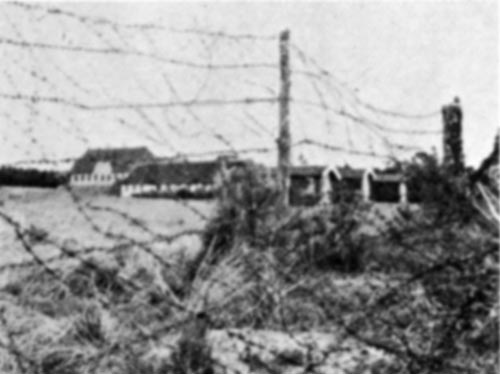 In March 1945 our property was occupied by German troops. On the picture three of our houses can be seen in the grounds of Klintegård
In March 1945 our property was occupied by German troops. On the picture three of our houses can be seen in the grounds of Klintegård It was in March 1945 that these five summerhouses were moved. The German commandant selected twenty soldiers who took up positions around the first of the houses. He thought that these twenty soldiers could carry the houses the distance of almost 200 metres to Klintegården. He commanded, "Lift!", and the soldiers "lifted" as much as they could, but the house remained standing unshakably on its cement pillars.
The commandant now realised that the removal couldn't be done this way, so he sent for a haulage contractor from Nykøbing, who came with a platform truck; now the removal of the houses was easy and done without difficulty.
Fortunately the war finished a couple of months later in May and we were able to get our houses moved back before the season began in June.
In 1946 the holiday colony was expanded so much that it became twice as big, and had to be renamed "Kosmos Holiday Centre(Kosmos Ferieby)". We bought "Klintsøgård (Klint Lake Farm)", a manor house that bordered on our area. To this manor house belonged some large plots of land that were suitable for building summer houses on. In addition there were four old farm houses and a couple of long, solid wooden buildings that could be converted fairly cheaply into holiday residences. In these residences, plus the main building, there was room for a large number of our holiday guests. And in the main building a guesthouse and a dining-room were also established.
The large area of land that belonged to the manor house was now divided into summer-house lots and were sold to people interested in the cause.
And then one summer house after another shot up.
The 20-30 summer houses that had by now been built in the oldest part of the holiday centre were also sold to people interested in the cause.
The reason why the houses had to be sold were, first, that we always lacked capital and secondly that it became gradually impossible for my few co-workers to look after and maintain so many houses, so they were sold to supporters of my work.
We were able to keep the manor house "Klintsøgård" for only seven years since it turned out to be completely impossible to make it pay. It could be let out for only 5-6 weeks each year, and that was far too little.
So we sold Klintsøgård; the new owner established it as a health resort and later as a convalescent home.
But we saw the value of the large areas of land that had belonged to Klintsøgård. The dividing into lots and selling of these areas gave us some very badly needed money.
On one of these lots a large new lecture hall was later built. This hall was the third in the holiday centre. After 11 years the first hall, which was initiated in 1937, had become too small and in 1948 it was replaced by a new hall that could accommodate twice as many.
Some years later this hall also became too small, and now we were able to build an even larger hall which we placed near Klintsøgård. We may be able to buy Klintsøgård back some day.
How did you find capital for these big projects?
The financial situation was very much helped by the fact that many hundreds of supporters of my work collected money as a present for me every year on my birthday. And every year in December they collected money in the same way for a cash Christmas present.
There was also a lady who placed a large sum at our disposal. She and her husband had lived in the provinces. Now he was dead and had left her with over a million Danish crowns. She moved to Copenhagen and became so interested in my work that she wanted to help us and offered to place a large sum at our disposal; we in return had to guarantee her interest for the rest of her life. She was to be paid a certain sum every quarter for as long as she lived, a sum that was ample for her to live on.
In the winter of 1951-52 I gave a series of lectures in the students' union's large assembly hall in Copenhagen, which could hold 550 people. The lectures took place every second Monday; there were twelve in all.
Can you remember the titles of any of the lectures?
Yes, I talked about many different subjects: "Reincarnation and immortality", "The universe and the living being", "Beyond death and the physical plane", "The highest fire and the sexual mystery", "The birth of a new world culture" and so on. The lectures were accompanied by slides, and they were later published as books.
In the spring of 1952 I gave 6 lectures in Oslo, where there was now some interest in my work.
In the same period I gave lectures as usual at our institute and in a series of provincial towns.
On my 64th birthday, 11 August 1954, my childhood home, "Moskildvad" near Sindal, was bought by one of the supporters of my cause, Sam Zinglersen. His plan was to bring the house back to its original form and to "re-inaugurate" it on my 100th birthday in 1990. The intention was that there should be a museum here; I was to explain in detail how the house was furnished when I was a child.
I have always regarded the area where I spent my childhood with heartfelt, loving feelings, and on my rare visits I have enjoyed wandering around and recalling memories from the past.
Haven't you also visited Iceland sometimes?
Yes, I have been to Iceland five times so far. And I will probably go there a few more times. My first visit was in 1952, when I was invited by the president of the Theosophical Society of Iceland, Gretar Fells, who had spent her holiday in our holiday centre in the summer of 1952.
I have found a tremendous loyalty and love in Iceland every time I have been there, and there have always been large audiences at my lectures in both Reykjavik and Akureyri.
I have accepted invitations to visit the President of Iceland and the Bishop of Iceland.
Once I was invited to a big ecclesiastical meeting with the country's 100 priests. It was a lovely experience for me and it showed me what a shining example of tolerance and understanding one can find among the Icelandic people. The priests go to one another's meetings, whether they are Adventists, members of the Inner Mission (A fundamentalist Christian sect. MMcG), spiritists, theosophists or anthroposophists. I don't think I could meet such tolerance in ecclesiastical circles in my own country.
I did, however, once meet a Danish priest who said that he naturally believed in reincarnation, but that he couldn't very well stand up and say so from the pulpit.
The ecclesiastical meeting, attended by 100 priests, took place at Reykjavik University, where I sat at table beside the Bishop of Iceland. He asked me to give a short lecture setting out my view of Christ.
I then told them that my view of Christ was not that he took upon himself punishment for the sins of Man. This was a misunderstanding and was not the greatest aspect of his mission. The greatest was that he, during his agony on the cross - at the culmination of the most terrible sufferings - with the final remains of his dying powers, could pray for his executioners and say, "Father, forgive them, for they know not what they do!"
My speech gave rise to tremendous applause, and the bishop thanked me for the lecture, saying that it came from the heart; he could feel that.
I also paid several visits to the well-known sculptor, Einar Jónsson, for whom the Icelandic state has built a unique museum.
He once wanted to model a bust of me. But we were a little late in thinking of it. I could only sit for the bust twice and that was not enough. He later finished the bust from memory, but it was unfortunately not a very good likeness. There were, however, others later who made busts of me.
I received an invitation from the well-known author, Kristmann Gudmundsson, who was also very friendly towards my work. He showed me how he was able to maintain an entire little botanical garden with thousands of different plants in the big greenhouse built onto his villa.
I was invited on some lovely car trips, so I had the opportunity to see the fairytale-like, beautiful country. I was driven through the shining gold of the midnight sun to the lunar landscapes in the great wastes of the lava fields. I saw the blinding light of the glaciers blending with the sky, and I saw down into the glowing interior of the volcano, Hekla. I was driven out to the great uninhabited pulsating of psychic forces among the mountains. I saw the hot springs and many other rare phenomena.
When I visited Thingvalla and came up to Øxará Waterfall, which I photographed, I was enveloped in an ecstatic feeling of bliss - without there being any apparent outer physical cause whatsoever of this state. I could feel it only as a greeting of welcome from beings who were not of this world. Here out in Iceland's wide open spaces, thousands of miles from the noisy rush of other nations, and their more or less Godless atmosphere, it is not so surprising that the higher levels of the spiritual world's atmosphere can more easily penetrate.
I have made many friends on this lovely island; some of them are working hard at translating my books into Icelandic.
Weren't you also in Japan and India?
Yes - in September 1954 I received a letter from Japan, which turned out to be an invitation to come to Japan and take part in a congress on world religion, sent by an influential movement in Japan called "Ananai-Kyo". The congress was to last 10 days and began on 23 October.
The official invitation to me was accompanied by a private letter from the president of Ananai-Kyo, Shin Negami. The following is an extract from his letter:
"As you will see in the enclosed letter of invitation, Ananai-Kyo is an international organisation whose task is the establishing of world peace through religion. As president of this organisation I have great pleasure in inviting you with this personal letter. I know that you work for the cause of peace here in the world, and this would be a good opportunity to cooperate with us. If you are not able to take part in the congress I would be very grateful to you if you could send me a speech on tape. We would broadcast your voice on the radio and translate the speech into Japanese. Thanking you in anticipation and hoping for an early reply I am your friend in the cause of peace,
Shin Negami
This friendly invitation gave me great confidence and interest in this cause, and I wanted to send a positive answer but there was a financial problem. The participants in the congress had to pay their fares themselves, though the stay in Japan was free.
I contacted a couple of airlines to ask about the price of a return ticket to Japan. The answers were not encouraging: the price was so high that I thought that it was completely prohibitive for me, and I was about to give up the thought of going to Japan.
But God had other ideas!
The news spread like lightning among the many supporters of my cause and a strong feeling arose that this journey mustn't be given up. A small group of the friends of my cause took charge of a collection and guaranteed me the travel money. Then I felt with my entire soul that it was God who had called. I was now to bring that knowledge or wisdom that God had given me to the wise men of the East, to people who struggled to create world peace by means of science and wisdom or spiritual science.
I sent a telegram to Japan, giving thanks for the invitation. I said that I would like to come on condition that there would be a Danish-Japanese interpreter at hand.
Before 24 hours had passed a telegram came from Japan: "Interpreter available. We are expecting you!"
It was therefore decided that I should go.
The rumour of my imminent journey to the East reached all the way to India, where my work already had some friends. And I now received an invitation from my Indian friends. They hoped that I would be their guest for a couple of weeks on the return journey, and that I would also give some lectures.
In addition I received an enquiry from the Danish consul in Cairo. He was also one of the friends of my cause, and he hoped that I could make a short stay in Cairo on my way home. Then he would show me some of the sights of Egypt, first and foremost, the pyramids.
My departure from Copenhagen took place at mid-day on Wednesday, October 20. A large number of my friends turned up at the airport to see me off and to wish me luck on the journey.
I flew the 16,000 kilometres with SAS, landing at Tokyo airport a little over 2 days later.
A representative of the Danish Legation in Tokyo was to meet me at the airport and help me settle in. I was to stay the night at the Grand Hotel in Tokyo, and the next morning I was to travel by express train for three hours to Shimizu, the town where the congress was being held.
But because of a misunderstanding the representative from the legation didn't turn up at the airport. This could well have put me in a difficult situation, but fortunately Providence was with me.
A Danish seamen's priest, who had a little contact with the legation and knew me by name, had heard that I was coming. And now he had had an impulse to go out to the airport and meet me. He was very happy to meet me and took me to my hotel in Tokyo. He was enormously interested in my work and asked a lot of spiritual questions, which I answered.
It was late by the time he left to go home, but early next morning he turned up again and we had breakfast together in the hotel restaurant.
He made contact by telephone with the managers of the congress in Shimizu, and it was arranged that two young Japanese came to accompany me on the three-hour train journey.
When we finally, late in the day, arrived at the railway station in Shimizu a crowd of people, waving the Danish flag, had gathered and I and my luggage were almost carried to a large luxury car.
We now arrived at the congress centre - a very large area with many buildings, offices, rooms and halls. The congress managers presented me to the president of the movement, who invited me to tea. But the Danish interpreter I had been promised had not turned up yet; so for the time being we had to manage with gestures and gesticulations.
I was shown the room in which I was to stay, and the next day the congress opened with a lot of speeches.
In this way the first couple of days passed; then there finally came a message that an interpreter had been found. He was a young Japanese who had lived in Denmark for eight months, teaching Japanese at a school in Copenhagen; so he could speak a little Danish. I sat now for a whole afternoon showing him my symbols, about which I was going to give a lecture in the evening.
Evening came, and the large hall filled with people coming to the congress from many countries. Most of these participants were coloured people.
I showed my symbols on the white screen and explained what they meant. The interpreter interpreted - as well as he could - every sentence into English and Japanese.
Among the participants there were many scientists, professors and influential people; they listened to the lecture with great interest. An Indian professor said after the lecture that I must be more a scientist than a philosopher.
Three Philippino participants were particularly interested and wanted to invite me to the Philippines.
The following day it was again my turn to stand on the rostrum and give a short lecture that I had prepared before I left home; it had been translated into English. But they wanted me to give it in Danish first. There were certainly not many that understood any of it, but they clapped politely afterwards all the same. The lecture was read out in English by an interpreter, and it was followed by very long applause. And after the lecture was finally read out in Japanese the audience almost brought the house down.
What was your lecture about?
My lecture was an answer to some questions that I and a number of other congress participants had received a month before the congress.
One of the questions was "What kind of welfare does the religion that is based on almighty God produce?"
I answered this question in this way:
"Such a religion, which is truly scientifically based on God, will in the first place give people a thorough knowledge that in an obvious way can clarify for people the true causes of all their sufferings and difficulties, the wars and mutilations, the illnesses and deaths, the need and misery that today make existence an Armageddon for mankind. This knowledge of the cause of darkness will of course make people change their materialistic policies in favour of turning all the people of the Earth into one people and one state or into the true international kingdom of the world, ruled or governed by a corresponding world government.
"The members of this world government will gradually come to consist only of initiated beings or cosmic scientists.
"The material administration of the world will be changed in favour of the protection of people from being ruthlessly exploited by other people. In the world state no human being will live at the expense of others.
"Every child that comes into the world will be trained and taught in precisely the fields that it has particular talents or abilities for. So everyone will find his or her niche.
"Money will disappear since it will gradually become totally superfluous.
"A small proportion of mankind, with the aid of machines, will be able to produce all the products vital to our material needs. This will not create unemployment but will go towards abolishing compulsory labour.
"In my main work, 'Livets Bog', I have made a detailed analysis of the future of mankind in this world kingdom.
"The culture of this world kingdom will, having reached its divine ultimate result or completed its creation, outshine everything that the human intellect today can comprehend. Here all-influential science will have long since removed hate and anger, the lethal and pathological sorts of thoughts and ideas from the human mentality.
"And the spirit of God in the form of the world religion based on this all-permeating science will, like a warming summer sun, rise up above the terrestrial human mental horizon and melt the ice-terrains of hate and war and make divine love vibrate in all hearts and shine in all eyes, and make every human hand caress and bless.
"In such a celestial or heavenly radiance the deadly shadows of the present cultural epoch and its murderous processes, its tendencies to mutilation and looting fade away and become nothing in this, the flood of rays of God's countenance."
All the speeches were broadcast on Japanese radio, and the many journalists who were there wrote long reports for newspapers and magazines.
On 30 October the congress ended. But most of the participants went on a trip to the southern Japanese town of Kurume, where the Ananai-Kyo movement had a temple.
It was a matter of a twenty-hour journey by express train; then the closing ceremony was to take place at the beginning of November. But I preferred to go to India to visit the friends I had there.
I flew to Madras, where I was met at the airport by Anna Ørnsholt, for many years one of my most interested followers abroad. She had moved from Denmark to India in 1925 and was now 72 years old. For a number of years she had been secretary to the famous scientist, J. Bose and later to Prime Minister Nehru.
Among her very extensive circle of acquaintances can be mentioned Tagore, Indira Gandhi, Annie Besant and Krishnamurti.
Through her my cause had gained its first foothold in India. Now she met me in Madras airport. First we visited the Danish Consul-General together; then we went by train to her beautifully situated house in the Nilgiri Mountains of South India.
I stayed here for some weeks and gave lectures in various towns. Anna Ørnsholt was a brilliant interpreter.
Invitations to give lectures streamed in from many places, and people wanted me to stay in India for at least three months. I couldn't, however, stay as long as that; I wanted to be home for Christmas.
One of the many invitations came from a well-known theosophist who was the leader of the theosophical centre in Bangalore. He has more recently visited me in Copenhagen. On the way to Bangalore we passed a town called Coimbatore, and here at the station I was adorned with flowers by an Indian sage who had turned up with his disciples to greet me. He had read some of my books and now, according to Indian custom, he took the opportunity to express his loving thanks to me.
I also gave a lecture in the theosophists' world headquarters in Adyar near Madras, and among the audience in their big temple hall were the president of the Theosophical Society and a mass of old sages with large beards and turbans. They sat on the floor and were all extremely interested. Afterwards they came up to me and shook my hand, something Indians never normally do.
One of the sages said, "When 'the great ones' were alive, I mean Helena Blavatsky, Annie Besant and Leadbeater, there was life in theosophy, but now they are dead it is dead too. But now you come and give it new life!"
A well-known professor wanted me to come to Bombay and give lectures. But since it couldn't be until after Christmas we had to give up the idea.
I also had the opportunity to meet Krishnamurti. He held a question hour for his followers in the great temple hall. I watched how he stepped into the hall and bowed to the audience, pressing the palms of his hands together in the Indian manner.
Then they all sat on the floor and the question hour began. The audience asked a number of questions, which he answered.
After the question hour I greeted him, expressing my admiration for the fact that in 1929 he had declined any form of worship as a world teacher.
To this he answered very briefly that that belonged to the past.
Didn't Anna Ørnsholt help with translating your books into English?
Yes. She has carried out a great deal of work at home translating "Livets Bog" and some of my other books. In this great task she was assisted by her friend, Lulu Wilding.
Now we had reached the middle of December and I had to think about my journey home. Since I had stayed in India too long I had to give up the planned landing in Cairo and a visit to the pyramids. But I hoped that I would later have the opportunity to visit both Egypt and Palestine. Anna took me to the airport in Madras and waved goodbye to me.
I landed at Copenhagen airport on December 17 and was met by a lot of the friends of my cause.
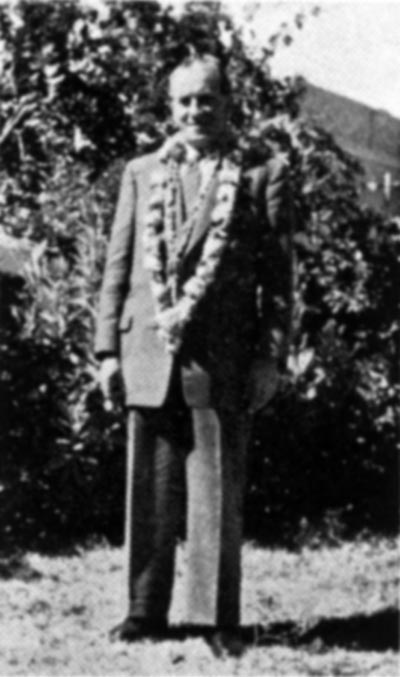 On the way to Bangalore we passed through the Coimbatore. At the station here I was decorated with flowers by an Indian guru we had turned up with his disciples to meet me.
On the way to Bangalore we passed through the Coimbatore. At the station here I was decorated with flowers by an Indian guru we had turned up with his disciples to meet me. 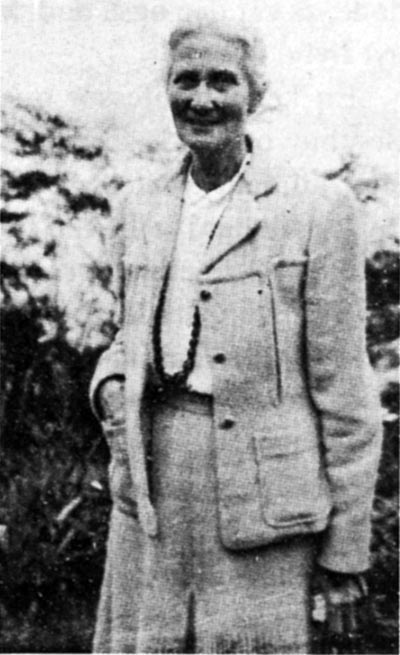 Anna Ørnsholt was my guide and interpreter in India. She had lived in India for over 30 years and had worked very much with translating my books into English.
Anna Ørnsholt was my guide and interpreter in India. She had lived in India for over 30 years and had worked very much with translating my books into English. My secretary, Gerner Larsson, has since been in India several times to help with the spreading of my work; he too has been very much helped by Anna Ørnsholt.
* * *
On my 70th birthday, 11 August 1960, my friends arranged a big party for me, which took place at our holiday centre in Klint, where a large tent to hold 400 people was put up. Here coffee, tea, bread and cakes were served and a number of speeches were made. Among the guests there were many from abroad: Swedes, Norwegians, Finns, Icelanders, Englishmen, Germans, Dutch; indeed, well-wishers even came all the way from India, Japan and America.
A large gift of money for the spreading of my work had been collected. I also received a "Festschrift", which, at the initiative of Professor I. G. Hannemann, had been financed by a number of those interested in my work. It was a beautiful 200-page book with 15 articles written by my friends.
It was the greatest day I had had to date.
* * *
Once a week, usually on a Thursday, I had a permanent invitation from two of my friends, Peter Zacho and Sam Zinglersen. And in the summer we often made little outings to the lovely northern part of Zealand (Sjælland). We often took one of our many acquaintances or a married couple with us in the car. We were very fond of the beautiful countryside along the coast of the Sound (Øresund). Or we drove to Fure Lake (Furesøen) or to Zeal Lake (Sjælsøen) or to some other beautiful place where we enjoyed the sunset. And then we would make our way to a little inn where we had a cup of evening tea and a cosy chat.
I enjoyed these Thursday evenings very much; they always lent variety to my daily existence. Peter and Sam wanted me to experience Egypt and "The Holy Land" of Palestine. I wanted this too, but I realised that it had to wait until I had finished "Livets Bog".
In the autumn of 1961 I was ready to accept their friendly offer of a trip to Egypt and Palestine. And on 12 October we flew with SAS to Egypt.
We landed in the evening at Cairo airport, where a stewardess asked us if we wanted a guide. She knew "Egypt's best guide", who was called Ali Muhamed. He was a 50-year-old Egyptian, the sheik of the nearby town of Mena with 10,000 inhabitants. He worked for SAS and could speak a little Danish.
Now he found rooms for each of us at the hotel Mena House, which is half-an-hour's drive from Cairo. The hotel is situated only a couple of hundred metres from the Cheops pyramid, the Sphinx and two smaller pyramids. But since it was now completely dark we could not see anything.
However, early the next morning I got up and went out onto the balcony, and now I saw the sun rising behind the gigantic Cheops pyramid. It was a wonderful sight. We enjoyed our breakfast in the hotel garden surrounded by lush palm trees.
Then Ali, our guide, arrived with three camels. He thought that we should start the day with a ride round the Great Pyramid. We were not used to riding camels but luckily they were three quiet, peaceful animals. They knelt when one wanted to mount them and sit between the two humps.
After the ride we, of course, had to see the inside of the pyramid, of course. Many years ago an entrance had been found that led to the long, steep corridor, which, via an enormous number of steps, ends in the King's Chamber in the middle of the pyramid. The only thing in the King's Chamber now is a black granite sarcophagus.
Was this sarcophagus used for royal burials?
No, that's a misunderstanding. It has never been used as a coffin. The common opinion about the pyramid is that it was built by the Egyptian king Cheops, who lived in Memphis around the year 2800 B.C. But this is quite wrong. The pyramid is actually 80,000 - 90,000 years old; it was built by means of spiritual forces for use during the initiation of the future pharaohs.
It was only those pharaoh-candidates who were spiritually the strongest who could resist the many mental trials that they experienced within the pyramid.
The pyramid was built in prehistoric times by a brotherhood or community of initiated people who came here from other more highly developed planets in order to assist in the forming of human civilisation here on Earth. They built the pyramid by psychic power, by a kind of materialisation or projection of the atoms of the substance.
When the candidate for initiation, after many difficulties and dangers in the lower subterranean corridors and caves, had finally reached the Queen's Chamber and had gone through the initiations there, he could ascend to the King's Chamber, where the great decisive trial awaited him. He was laid in the stone coffin and, by means of magical and hypnotic powers emanating from the adepts who were in charge of the initiation, his spirit (or I) was liberated from his physical organism for a while and, in the spiritual world, he was initiated into some of the secrets of the universe.
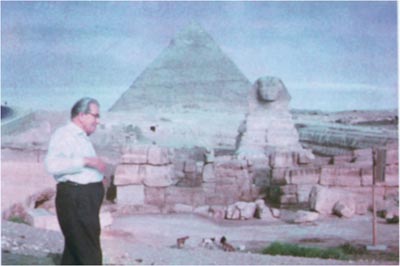 The sphinx and the pyramids were only a few hundred metres from our hotel.
The sphinx and the pyramids were only a few hundred metres from our hotel.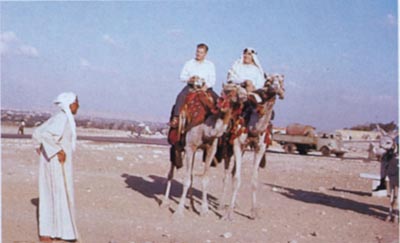 Ali, our guide, thought that we whould start our day with a ride around the great pyramid
Ali, our guide, thought that we whould start our day with a ride around the great pyramid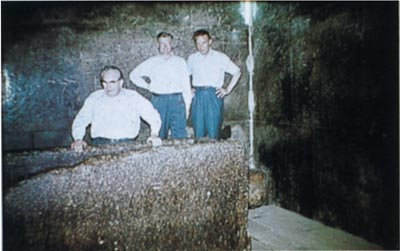 In the middle of Cheops pyramid lies the King's Chamber with its granite sarcophague.
In the middle of Cheops pyramid lies the King's Chamber with its granite sarcophague.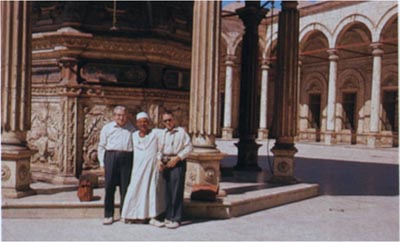 We saw some of Cairo's monumental mosques and other attractions.
We saw some of Cairo's monumental mosques and other attractions.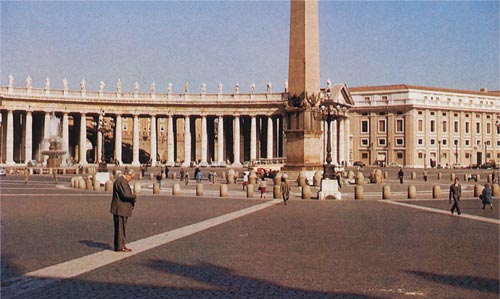 On our way home from Egypt and Palestine we visited Athens and Rome, where we saw the Coliseum and St. Peter's.
On our way home from Egypt and Palestine we visited Athens and Rome, where we saw the Coliseum and St. Peter's.If he thereafter was able to return to his physical body fully conscious of, and remembering, what he had experienced he was regarded as an initiate and entrusted the task of being king or leader of the rising generation.
In a vision I saw how the pyramid looked in those days. It was shining white, for its sides were covered with a hard porcelain-like material. Today there is desert around the pyramid, but in my vision there was a fertile oasis with lush palm trees.
As we were to go on to Palestine, we could stay in Egypt only for 3 - 4 days but all the same we managed to see a mass of interesting things, first and foremost Cairo's great national museum of Egyptian archaeology, which contains most of the great grave finds.
And, still with Ali as our guide, we visited some of Cairo's monumental mosques and in the Arab quarter we went through an oriental district of narrow, colourful bazaar streets thronged with people. And in a kind of gondola on our final evening we had a beautiful sail on the Nile.
But we were to travel on. Bidding Ali a heartfelt farewell, we flew from Cairo airport over the Sinai Peninsula and Mount Sinai, where Moses was given the tablets with the Ten Commandments on them.
After an hour's flight we landed at Jerusalem airport in Jordan. At that time the city was divided by a wall between Jordan and Israel. We stayed at a cosy little hotel on the outskirts of Jerusalem. It belonged to a small Arabic family, and the host himself served lovely vegetarian food for us every day. In the evening there was a curfew because of the tense situation between Jordan and Israel, so we had to keep indoors after dark.
We stayed in Jordan for five days. Here too we found a charming guide; he was Armenian and showed us round many of the Biblical sights and holy places. We went to the River Jordan and saw the place where John the Baptist, according to tradition, baptised Jesus.
We went to the church at Bethlehem, Isaac's grave, the Garden of Gethsemane and many other places.
Near the Garden of Gethsemane was the house of Caiaphas. Here we saw the deep cellars where Jesus was whipped.
From there we walked through the Valley of Kedron by the Via Dolorosa (The Road of Pain) to the Church of the Holy Sepulchre, which is situated within the city wall.
As the name suggests, this church is said to have been built over Jesus' grave, but there are various reasons to doubt that this is the right place. Several different sects each own their part of this church and they all want to make as much profit as possible from the tourists. Our guide told us that they often quarrel with one another. Sometimes, especially during the religious festivals when there are thousands of pilgrims and visitors, they can even come to blows. It shouldn't be like that in such a holy place. The spiritual atmosphere wasn't as good as one might have expected.
From here our guide took us to the Garden of Peace outside the old city wall. This garden was filled with beautiful flowers and there was quite a different peaceful and elevated atmosphere here. Many are of the opinion that it was really here that Jesus was buried.
The place was discovered around 1880 by the English General Gordon, who was also an archaeologist. He couldn't understand that it could be right that Golgotha (also known as Calvary) was inside the city wall. He noticed that a couple of hundred metres from this there was a high, round hill, rather like a skull in shape, and he knew that the name Golgotha meant "skull". He began to dig in this place. At the foot of the hill three burial places had been dug out. Science has been able to prove that a corpse had lain in only one of them.
Silently we walked into this burial place, feeling deeply moved by its atmosphere. Our road from the Garden of Gethsemane to Golgotha had come to an end.
In front of the burial place there was a stone furrow in which a large stone, like a millstone, had been used to roll in front of the grave. Inside the Church of the Holy Sepulchre we had seen such a stone, which perhaps really belongs in the Garden of Peace.
We also went up on the Samaritans' holy mountain, Garizim, where the Arc of the Covenant disappeared. And one afternoon we visited Mount Nebo from where Moses beheld the Promised Land, and where he later died. Up here there was a monastery; a monk showed us round.
When we later drove down the stony road from Mount Nebo I thought that our driver was in too much of a hurry. He wanted to get home before dark, and this was the reason for his very hazardous driving. I didn't feel safe in this situation; we all wanted, naturally, to get home again safe and sound. But just when my uneasiness reached its peak something happened that immediately made my nervousness disappear. In a vision I saw a tall, shining figure, dressed in a long robe walking along the road in front of the car. I was the only one who could see the figure, and the remarkable thing was that, despite the fact that the figure moved at a slow and stately pace, it was all the time a little in front of the car.
I now understood that we were protected; we then got safely back to our hotel.
On our fifth and last day in Jordan our guide thought that we should experience something out of the ordinary. He suggested that we took a whole-day trip to the ancient ruined city of Petra, which lies 100 kilometres to the south of the Dead Sea.
To go so far we had to get up very early in the morning. We went in a large taxi and had both a driver and a guide with us. After a little over an hour's drive we reached the capital Amman, where we topped up the taxi's petrol tank.
From there we travelled south through extensive desert areas. Some scattered Bedouin camps were about the only things we saw on the 200-kilometre-long desert road.
When we were a little more than 7 kilometres from Petra the car stopped at a large Bedouin camp, and we were told the road for cars didn't go any further. The last stretch was to be covered on horseback. We were not prepared for this, and I wasn't particularly happy about the situation.
The Bedouin here lived on renting out horses to tourists going to Petra. I saw that they had at least 40 rather small Arab horses.
We discussed the matter. None of us was used to riding, it was the middle of the day and the sun was burning hot.
We agreed that we had to try to manage the last bit of the road now that we had taken so long to come so far. There was no way round it - we had each to climb onto and ride our horses.
We made up quite a little caravan. The guide rode in front, then the driver. Then came Peter followed by me and, behind me, Sam and two Bedouin boys on a donkey with our provisions. A Bedouin walked in front of each horse holding it by the reins.
We were somewhat tired when we finally reached the ruined city. The last kilometre went through a ravine with high cliffs on each side.
Now we could at last get off the horses and admire this interesting ancient city. It had been the capital of the Arabic tribe, the Nabateans, who flourished in the centuries before and after the time of Christ. Here there are many ruins from the early Roman Empire, among other things a temple of Isis and an amphitheatre hewn out of the cliffs. Our guide showed us around and finally we found a place where we could sit in the shade and eat the food we had brought with us. After that we climbed back on our horses and covered the 7 kilometres to the Bedouin camp where our taxi was waiting for us.
We were satiated with impressions when we arrived back at the hotel late in the evening.
Our time in Jordan was now over and we bade a heartfelt farewell to our obliging hotelier and his staff.
Now we were to experience Israel.
Our guide took us to the border of "No-Man's Land". For the Arabs, Israel was white on the map; they would not acknowledge that the country existed.
From here we walked with our suitcases almost half a kilometre to the Israeli frontier outpost, and now we were in Israel - in the Israeli part of Jerusalem.
After we had rested for a few hours in the garden of the King David Hotel, we travelled by train to Haifa, where we stayed for a couple of days. And from here we made excursions to Nazareth, Capernaum, the Sea of Galilee and several other Biblical places.
When we had four days left of our holiday we flew to Athens, where we saw the Acropolis and other monuments of Ancient Greece.
And finally we went to Rome, where we visited St. Peter's, the Coliseum, the Roman forum and the catacombs.
Then we flew home to Copenhagen. It was good to come back safely from this eventful journey. I often think of it. Our wonderful experiences have become gold copies in my consciousness.
-----------------------------------
This ends Martinus' part of "Memoirs". They were taped in 1963 when he was about 73. In the coming editions of KOSMOS we will publish Tage Buch's "Afterword" to the Memoirs, which covers the last 17-18 years of Martinus' life and work.
To be continued in Part Seven
>>
© Martinus Institut 1981, www.martinus.dk
You are welcome to make a link to the above article stating the copyright information and the source reference. You are also welcome to quote from it in accordance with the Copyright Act. The article may be reproduced only with the written permission of the Martinus Institute.







